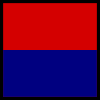Royal Regiment of Artillery
| Royal Regiment of Artillery | |
|---|---|

Cap Badge of the Royal Regiment of Artillery
|
|
| Active | 1716–present |
| Allegiance |
|
| Branch |
|
| Role | Artillery |
| Size | 14 Regular regiments 5 Reserve regiments |
| Garrison/HQ | Various: Larkhill (Regimental HQ), Catterick, Tidworth, Colchester, Hohne |
| Motto(s) | Ubique Quo Fas Et Gloria Ducunt ("Everywhere That Right And Glory Lead"; in Latin fas implies "sacred duty") |
| Colours | The guns are regarded as the regimental colours and are accorded the same compliments as the Standards, Guidons and Colours of the Cavalry and Infantry |
| March | British Grenadiers / Voice Of The Guns (Quick); The Royal Artillery Slow March colloquially known as The Duchess of Kent (Slow); The Keel Row (Trot); "Bonnie Dundee" (Canter) |
| Commanders | |
| Captain General | HM The Queen Elizabeth II |
| Master Gunner, St James's Park | General Sir Timothy Granville-Chapman |
| Insignia | |
| Tactical Recognition Flash |  |
The Royal Regiment of Artillery, commonly referred to as the Royal Artillery (RA), is the artillery arm of the British Army. Despite its name, it comprises a number of regiments.
The introduction of artillery into the English army came as early as the Battle of Crécy in 1346.Henry VIII made the army's artillery semi-permanent in the sixteenth century but the recognition of the need for a permanent body of artillery did not happen until 1716.
Before the 18th century, artillery 'traynes' were raised by royal warrant for specific campaigns and disbanded again when they were over. (Personnel for this purpose were drafted in either from the Tower of London, headquarters of the Ordnance Office, or else from the small teams of gunners based at various castles and forts around the country.) On 26 May 1716, however, by royal warrant of George I two regular companies of field artillery, each 100 men strong, were raised at Woolwich. The title "Royal Artillery" (RA) was first used in 1720. On 1 April 1722 the two companies were increased to four and grouped with independent artillery companies at Gibraltar and Minorca to form the Royal Regiment of Artillery, commanded by Colonel Albert Borgard. In 1741 the Royal Military Academy was formed in the Royal Arsenal at Woolwich (RWA) to provide training for RA and Royal Engineers (RE) officers. The regiment expanded rapidly and, by 1757, had 24 companies divided into two battalions, as well as a cadet company formed in 1741. During 1748, the presidential artilleries of Bengal, Madras and Bombay were formed. 1756 saw the creation of the Royal Irish Regiment of Artillery. In 1762 the Royal Artillery Band was formed at Minden. By 1771 there were 32 companies in four battalions, as well as two "invalid companies" comprising older and unfit men employed in garrison duties. During 1782, the regiment moved to the Royal Artillery Barracks (front parade) on Woolwich Common. In January 1793, two troops of Royal Horse Artillery (RHA) were raised to provide fire support for the cavalry, augmented by two more in November 1793. All RHA personnel were mounted. The Royal Irish Artillery was absorbed into the RA in 1801. During 1805, the Royal Military Academy moved to Woolwich Common. In 1819, the Rotunda was given to the regiment by the Prince Regent to celebrate end of the Napoleonic Wars. (It was originally built in St. James's Park as the outer casing of the tent in which the Prince Regent entertained the Allied sovereigns in 1814.) In 1832, the regimental motto, Ubique Quo Fas Et Gloria Ducunt ("Everywhere That Right And Glory Lead"; in Latin fas implies "sacred duty"), was granted. The motto signified that the regiment had seen action in all the major conflicts of the British Army and almost all of the minor ones as well.
...
Wikipedia
